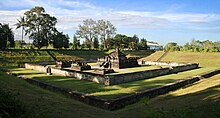লাহার: সংশোধিত সংস্করণের মধ্যে পার্থক্য
নতুন পৃষ্ঠা: {{কাজ চলছে/লক্ষ্য এবার লক্ষ}} Image:Hot lahar at Santiaguito.jpg|thumb|A lahar travels down a river valley in Guatemal... |
(কোনও পার্থক্য নেই)
|
১৬:৪২, ২৪ ডিসেম্বর ২০২০ তারিখে সংশোধিত সংস্করণ
এই নিবন্ধটি উইকিপিডিয়ার বিশেষ এডিটাথন লক্ষ্য এবার লক্ষ এডিটাথন উপলক্ষ্যে তৈরি করা হচ্ছে। নিবন্ধটিকে একটি নির্দিষ্ট সময়ের মধ্যে নিবন্ধকার অনুবাদ করে এর মানোন্নয়ন ও সম্প্রসারণ করবেন। আপনার যেকোনো প্রয়োজনে নিবন্ধের আলাপ পাতাটি ব্যবহার করুন। এডিটাথনে জমা দেওয়ার পূর্বে কিংবা নিবন্ধ বা অনুচ্ছেদটি কয়েকদিনের জন্য সম্পাদনা করা না হলে অনুগ্রহপূর্বক এই টেমপ্লেটটি সরিয়ে ফেলুন ও প্রযোজ্যক্ষেত্রে প্রয়োজনীয় টেমপ্লেট যুক্ত করুন। আপনার আগ্রহের জন্য আপনাকে আন্তরিক ধন্যবাদ।৩ বছর আগে Nettime Sujata (আলাপ | অবদান) এই নিবন্ধটি সর্বশেষ সম্পাদনা করেছেন। (হালনাগাদ) |

A লাহার ( /ˈlɑːhɑːr/, from জাভানীয়: ꦮ꧀ꦭꦲꦂ) is a violent type of mudflow or debris flow composed of a slurry of pyroclastic material, rocky debris and water. The material flows down from a volcano, typically along a river valley.[১]
Lahars are extremely destructive: they can flow tens of metres per second, they have been known to be up to ১৪০ মিটার (৪৬০ ফু) deep, and large flows tend to destroy any structures in their path. Notable lahars include those at Mount Pinatubo and Nevado del Ruiz, the latter of which killed thousands of people in the town of Armero.
Etymology
The word lahar is of Javanese origin.[২] The geological term was introduced by Berend George Escher in 1922.[৩]
Description

A lahar is a volcanic mudflow or debris flow.[৪] Lahars have the consistency, viscosity and approximate density of wet concrete: fluid when moving, solid at rest.[৫] Lahars can be huge. The Osceola Lahar produced by Mount Rainier (Washington) some 5600 years ago resulted in a wall of mud ১৪০ মিটার (৪৬০ ফু) deep in the White River canyon, which covered an area of over ৩৩০ বর্গকিলোমিটার (১৩০ মা২), for a total volume of ২.৩ ঘনকিলোমিটার (১⁄২ মা৩).[৬]
A lahar of sufficient size and intensity can erase virtually any structure in its path, and is capable of carving its own pathway, making the prediction of its course difficult. Conversely, a lahar quickly loses force when it leaves the channel of its flow: even frail huts may remain standing, while at the same time being buried to the roof line in mud. A lahar's viscosity decreases with time, and can be further thinned by rain, but it nevertheless solidifies quickly when coming to a stop.
Lahars vary in size and speed. Small lahars less than a few metres wide and several centimetres deep may flow a few metres per second. Large lahars hundreds of metres wide and tens of metres deep can flow several tens of metres per second (22 mph or more): much too fast for people to outrun.[৫] On steep slopes, lahar speeds can exceed ২০০ কিলোমিটার প্রতি ঘণ্টা (১২০ মা/ঘ).[৫] With the potential to flow distances of more than ৩০০ কিলোমিটার (১৯০ মা), a lahar can cause catastrophic destruction in its path.[৭]
Lahars from the 1985 Nevado del Ruiz eruption in Colombia caused the Armero tragedy, which killed an estimated 23,000 people, when the city of Armero was buried under ৫ মিটার (১৬ ফু) of mud and debris.[৮] A lahar caused New Zealand's Tangiwai disaster,[৯] where 151 people died after a Christmas Eve express train fell into the Whangaehu River in 1953. Lahars have been responsible for 17% of volcano-related deaths between 1783 and 1997.[১০]
আরো দেখুন
তথ্যসূত্র
- ↑ "Lahar"। USGS Photo Glossary। সংগ্রহের তারিখ ২০০৯-০৪-১৯।
- ↑ Vallance, James W.; Iverson, Richard M. (২০১৫)। "Chapter 37 – Lahars and Their Deposits"। Sigurdsson, Haraldur। Encyclopedia of Volcanoes। Amsterdam: Academic Press। পৃষ্ঠা 649–664। আইএসবিএন 978-0-12-385938-9। ডিওআই:10.1016/B978-0-12-385938-9.00037-7।
- ↑ Vincent E. Neall (২০০৪)। "Lahar"। Andrew S. Goudie। Encyclopedia of Geomorphology। 2। পৃষ্ঠা 597–599। আইএসবিএন 9780415327381।
- ↑ Gerrard, John (১৯৯০)। Mountain Environments: An Examination of the Physical Geography of Mountains। MIT Press। পৃষ্ঠা 209। আইএসবিএন 978-0262071284।
- ↑ ক খ গ টেমপ্লেট:USGS
- ↑ Crandell, D.R. (১৯৭১)। "Post glacial lahars From Mount Rainier Volcano, Washington"। U.S. Geological Survey Professional Paper। Professional Paper। 677। ডিওআই:10.3133/pp677
 ।
।
- ↑ Hoblitt, R.P.; Miller, C.D.; Scott, W.E. (১৯৮৭)। "Volcanic hazards with regard to siting nuclear-power plants in the Pacific northwest"। U.S. Geological Survey Open-File Report। Open-File Report। 87–297। ডিওআই:10.3133/ofr87297
 ।
।
- ↑ "Deadly Lahars from Nevado del Ruiz, Colombia"। USGS Volcano Hazards Program। ২০০৭-০৮-২৪ তারিখে মূল থেকে আর্কাইভ করা। সংগ্রহের তারিখ ২০০৭-০৯-০২।
- ↑ "Lahars from Mt Ruapehu" (পিডিএফ)। Department of Conservation (New Zealand)। ২০০৬। সংগ্রহের তারিখ ৫ নভেম্বর ২০১৬।
- ↑ Tanguy, J.; ও অন্যান্য (১৯৯৮)। "Victims from volcanic eruptions: a revised database"। Bulletin of Volcanology। 60 (2): 140। এসটুসিআইডি 129683922। ডিওআই:10.1007/s004450050222।
